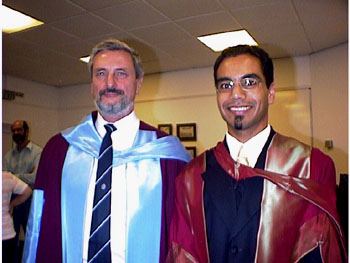Adaptive Meshing with Higher Order Boundary Elements
 Recently José Carlos Miranda an Engineering Graduate from the Prestigious Institute of Technology of Monterrey in Mexico, satisfactorily completed his PhD thesis and passed the examination conducted by Dr. Ali El-Zafrani of the School of Mechanical Engineering at Cranfield University as External Examiner and Dr. Robert Adey, Head of the Industrial Research Division at WIT, as the Internal Examiner.
Recently José Carlos Miranda an Engineering Graduate from the Prestigious Institute of Technology of Monterrey in Mexico, satisfactorily completed his PhD thesis and passed the examination conducted by Dr. Ali El-Zafrani of the School of Mechanical Engineering at Cranfield University as External Examiner and Dr. Robert Adey, Head of the Industrial Research Division at WIT, as the Internal Examiner.
José Carlos prepared a very detailed thesis on Adaptive Meshing with Higher Order Boundary Elements.
In his work, new proposals for the computation of efficient and reliable error indicators in the Boundary Element Method are presented. These error indicators take advantage of the Tangent Derivative Boundary Integral Equations to directly estimate the error in the numerical solution for the boundary stresses.
The basic idea behind the error indicators is to compare, on an element by element basis, two different solutions for the boundary stresses. In this sense, it is assumed that the bigger the difference between the two solutions, the bigger the error in the stresses.
For this purpose, two approaches are explored. The first one is aimed at two-dimensional Hermite and three-dimensional Hermite-like elements. The second one is formulated for its use with two- and three-dimensional Lagrangian elements.
For two-dimensional Hermite and three-dimensional Hermite like elements, the first solution is otained from an anlysis using these types of elements. The second solution is obtained by using some of the degreed of freedom of the Hermite or Hermite like elements to approximate the field variables inside the elements using conventional Lagrangian shape functions.
For two- and three-dimensional Lagrangian elements, the first solution is the standard solution obtained through use of this type of elements. The second solution is obtained employing the global reanalysis technique which is a post-processing activity that is carried out once an analysis with the Lagrangian elements has been performed. This technique consists in collecting the Tangent Derivative Boundary Integral equations at each functional node to obtain more accurate nodal values of the tangential derivatives of the displacements, which leads to the obtention of more accurate stresses.
Several different numerical examples were presented to demonstrate the efficiency and reliability of the new error indicators. Examples included problems in two- and three-dimensional elastostatics and two-dimensional steady state thermoelasticity.
The thesis was thoroughly examined by Dr. El-Zafrani and as a result it has been reccommended that José Carlos be awarded the PhD degree.
José Carlos has made numerous friends during his stay at the Institute and was always very much involved with all the Lodge activities. We hope that he will continue to be associated with WIT in the future.

 Wessex Institute
Wessex Institute